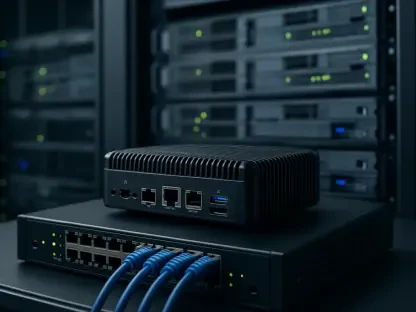The telecommunications industry stands at a critical juncture where the convergence of Artificial Intelligence (AI), 5G networks, and edge computing is reshaping the digital landscape in profound ways. These transformative technologies offer unparalleled opportunities for faster connectivity, smarter applications, and enhanced user experiences, but they also bring to light significant vulnerabilities in current network infrastructure. A single moment of downtime can disrupt everything from video calls to Internet of Things (IoT) systems, eroding customer trust and costing the industry billions in losses. The pressure is on for telecom operators to redefine reliability, ensuring their networks can handle the intense and often unpredictable demands of an AI-driven era. This article delves into the urgent challenges posed by these innovations, examining why resilience must become the cornerstone of modern telecom strategy. It also explores actionable solutions and forward-thinking approaches to safeguard networks against disruptions in this rapidly evolving environment.
The Rising Demands of a Connected Era
The integration of AI, 5G, and edge computing has unleashed a technological revolution within telecom, promising to elevate service delivery to unprecedented levels. However, this trio also places immense strain on existing infrastructure, demanding ultra-low latency and continuous data access to function effectively. AI applications, for instance, rely on real-time processing for tasks such as voice recognition or autonomous vehicle coordination, while 5G amplifies the need for speed across countless connected devices. Edge computing, by decentralizing data processing closer to users, further complicates the equation with its need for flawless synchronization. When networks falter, the consequences are immediate—dropped connections, delayed responses, and frustrated users. This heightened sensitivity to disruptions underscores a fundamental shift: traditional network designs, built for predictable loads, are no longer sufficient to meet the dynamic requirements of today’s digital ecosystem, pushing telecom to rethink its approach to stability.
Beyond the technical demands, the stakes of network reliability have never been higher as industries and consumers alike grow dependent on seamless connectivity. A brief outage can halt critical operations in sectors like healthcare, where telemedicine relies on uninterrupted video feeds, or in smart cities, where IoT sensors manage traffic flow. The unpredictability introduced by AI workloads, such as sudden spikes during large-scale model training or real-time inference at the edge, adds another layer of complexity. Unlike past traffic patterns that followed discernible trends, these modern demands fluctuate wildly, making it challenging to anticipate and mitigate risks. Telecom operators must grapple with the reality that even minor hiccups can cascade into widespread dissatisfaction, damaging brand reputation in an instant. This environment necessitates a proactive stance, where networks are engineered to absorb shocks and maintain performance under the most erratic conditions, ensuring that innovation does not come at the cost of dependability.
Reliability as a Non-Negotiable Priority
In today’s hyper-connected world, reliability has evolved from a desirable feature into an absolute necessity for telecom providers aiming to stay competitive. Industry reports, such as those from Cisco, estimate that network outages have resulted in losses amounting to $160 billion in a single year, highlighting the staggering financial impact of downtime. Beyond monetary costs, failures erode customer loyalty, as users expect consistent access to services whether they are streaming high-definition content or relying on smart home devices. Businesses, too, suffer when communication lines falter, disrupting operations and potentially leading to lost opportunities. Resilience must therefore be embedded into the very foundation of network architecture, transforming it into a core principle rather than an afterthought. For telecom operators, this shift is critical to sustaining trust and delivering the next-generation experiences that customers and enterprises demand in an increasingly digital age.
Achieving this level of reliability requires a fundamental departure from reactive fixes to a mindset of prevention and preparedness. Modern telecom networks must be designed with the expectation of stress, incorporating mechanisms to withstand and recover from disruptions swiftly. This is particularly vital as the adoption of 5G expands, connecting billions of devices and amplifying the potential fallout from any single point of failure. The emphasis on resilience also aligns with broader business continuity goals, ensuring that telecom providers can support critical applications without interruption. Whether it’s enabling remote work through stable video conferencing or powering autonomous systems with real-time data, the ability to maintain uptime is what separates industry leaders from laggards. As the digital landscape continues to evolve, embedding reliability into every layer of operations becomes the benchmark for success, pushing telecom to innovate not just in technology but in strategic planning as well.
Innovative Tools to Combat Network Risks
To address the mounting challenges of reliability, telecom operators can draw inspiration from data center practices, adopting cutting-edge tools to enhance network stability. Predictive analytics stands out as a powerful solution, leveraging real-time telemetry to anticipate demand surges or potential failures before they occur. By analyzing patterns and anomalies, this technology enables providers to allocate resources dynamically and prevent bottlenecks. Similarly, automation plays a pivotal role by allowing systems to respond to issues instantly, reducing the risk of human error during critical moments. These intelligent approaches shift the focus from firefighting to foresight, empowering telecom to maintain service quality even under intense pressure. As AI and 5G continue to push boundaries, integrating such proactive tools becomes essential for staying ahead of disruptions in a complex and fast-paced digital environment.
Another game-changing strategy lies in the use of Out-of-Band (OOB) management, which provides an independent access channel to control networks during primary failures. This is especially valuable for remote or hard-to-reach sites where physical intervention is impractical, ensuring that operators can troubleshoot and restore services without delay. OOB management acts as a safety net, preserving operational continuity when standard pathways are compromised. Combined with predictive analytics and automation, it forms a robust toolkit for tackling the unique stressors of modern telecom infrastructure. These solutions are not mere stopgaps but represent a forward-thinking approach to building networks that can adapt to the unpredictable nature of AI-driven workloads and 5G connectivity. By investing in such technologies, telecom providers can mitigate risks effectively, safeguarding both their operations and the expectations of an increasingly connected user base.
Challenges of a Distributed Network Landscape
The transition to distributed network architectures, driven by 5G small cells and Multi-access Edge Computing (MEC) nodes, offers significant performance benefits but also introduces new vulnerabilities. By processing data closer to end users, these systems reduce latency and enhance efficiency, yet they multiply the number of potential failure points across the network. Each additional endpoint, whether a small cell in an urban area or an edge node in a rural setting, becomes a possible weak link that could trigger disruptions. The complexity of managing thousands of distributed components heightens the risk of localized issues escalating into broader outages, impacting everything from consumer services to industrial applications. Telecom operators must therefore prioritize strategies that address this intricate web of connections, ensuring that the advantages of distributed systems do not undermine overall network integrity.
To counter these risks, robust failover mechanisms and layered security protocols are indispensable for maintaining stability in a distributed environment. Failover strategies ensure that if one node falters, traffic can be rerouted seamlessly to prevent service interruptions, while security measures protect against breaches that could exploit the expanded attack surface. Geographic diversity—spreading infrastructure across varied locations—further bolsters resilience by reducing the likelihood of a single event, such as a natural disaster, crippling the entire network. Telecom providers must also invest in real-time monitoring to detect and address anomalies at the edge before they spiral out of control. This multifaceted approach is crucial for balancing the performance gains of distributed architectures with the imperative of reliability. As edge computing becomes more pervasive, the ability to manage its inherent complexities will define the success of telecom operators in delivering consistent, high-quality service across diverse and demanding use cases.
Empowering Teams for a Resilient Tomorrow
While technology forms the backbone of network reliability, the human element remains equally critical in navigating the challenges of an AI-enhanced telecom landscape. Recognizing this, approximately 30% of industry leaders, including Chief Information Officers and Chief Security Officers, are channeling resources into training programs to equip their teams with essential skills. These initiatives focus on mastering the interpretation of predictive alerts, conducting realistic outage simulations, and establishing streamlined escalation protocols for crisis management. By fostering a workforce capable of handling sophisticated systems, telecom operators ensure that technical solutions are complemented by human expertise. This synergy between tools and talent is vital for minimizing downtime and maintaining service excellence, particularly as networks grow more intricate with the integration of AI and 5G technologies.
Beyond training, fostering a culture of collaboration and preparedness across teams enhances the industry’s capacity to respond to disruptions effectively. Cross-functional coordination ensures that technical, operational, and strategic units work in unison during emergencies, reducing response times and mitigating impact. Regular drills simulate high-pressure scenarios, allowing staff to refine their decision-making under stress and identify gaps in existing processes. Clear communication channels, both within organizations and with external partners, further streamline efforts to restore services swiftly. This emphasis on human readiness underscores that resilience is not solely a technological endeavor but a holistic one, requiring investment in people as much as in systems. As telecom continues to evolve, building a skilled and adaptable workforce will be a cornerstone of sustaining reliability amidst the unpredictable demands of modern connectivity.
Charting the Path to Future-Proof Networks
Reflecting on the journey, telecom operators have grappled with unprecedented challenges as AI, 5G, and edge computing redefined network expectations. The financial toll of outages and the erosion of customer trust during disruptions highlighted the urgent need for resilience. Industry leaders tackled these issues head-on, integrating predictive analytics to foresee problems and automation to resolve them swiftly. They fortified distributed architectures with failover plans and prioritized human training to ensure readiness. These efforts marked a pivotal shift toward proactive management, setting a new standard for reliability in a digitally driven world.
Looking ahead, the path to enduring success lies in embedding resilience into every facet of network planning and operation. Telecom providers should deepen investments in AI for predictive maintenance and expand automation frameworks to enable seamless, zero-touch configurations. Establishing industry-wide resilience standards through collaboration among carriers and partners will further strengthen the ecosystem. By embracing layered architectures with redundancy and independent access paths, the sector can confidently meet the dynamic challenges of tomorrow. These steps ensure that past vulnerabilities pave the way for robust, future-ready networks capable of supporting innovation without compromise.









